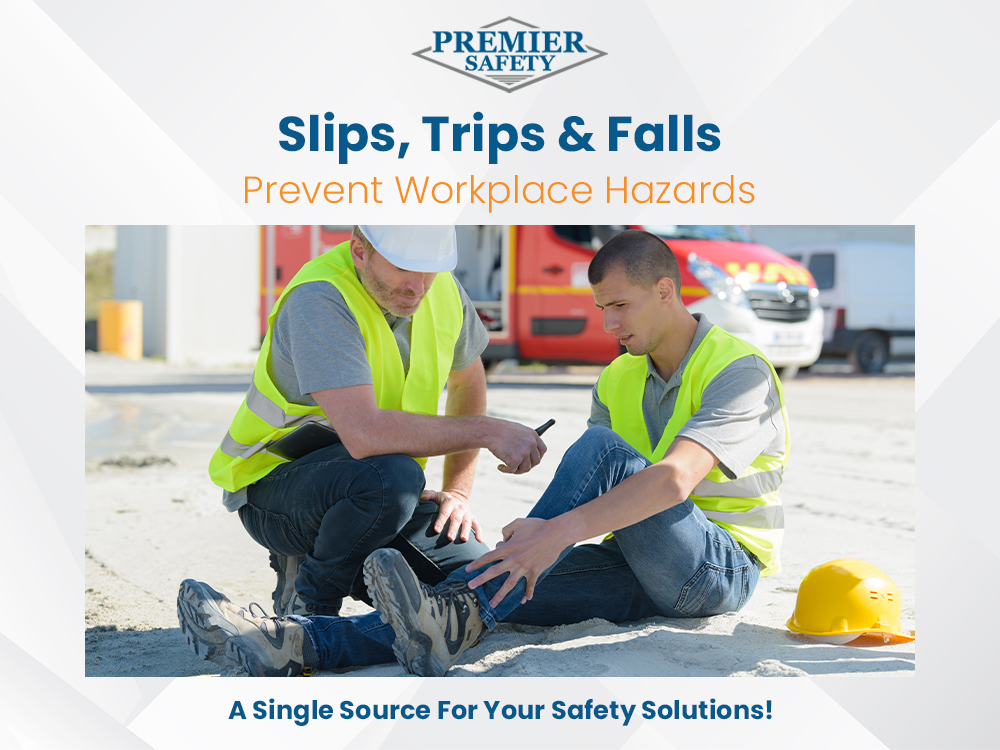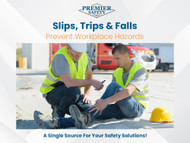Prevent Slips, Trips and Fall with These Simple Steps
Posted by Premier Safety on Jun 17th 2022

"Watch your step" is a message we would share each morning as people filter into their work area. As leaders in safety solutions, we recognize that because of familiarity; walking surfaces often times gets overlooked. In fact, some may find humor when someone slips, trips or falls. However, what if we told you that according to the Bureau of Labor Statistics; slips, trips, and falls contribute to over 700 deaths annually and many more injurious workplace accidents. Today we will address the common cause of slips as well as how to prevent tripping hazards and fall incidents.
How to Prevent the Most Common Causes of Slips, Trips, and Falls
Whenever workplace injuries and deaths are discussed, we must remember these preventable injuries are sometimes caused by friction, momentum, and gravity. Slippery surfaces are a common reason for loss of friction which is the most notable reason for workplace slips. A slip is the result of too little friction between your feet and the surface you are walking or working on. Wet surfaces, spills, or weather hazards like ice or snow can cause slips and falls. The chances of slipping increase when you rush or run, wear the wrong kind of shoes, or simply not paying attention to where you're walking. Oftentimes, these accidents result in fractures and dislocations, which are unsurprisingly among the most common injuries. Typically, ankle fractures and wrist fractures occur, but fingers may also be broken. Dislocations of the shoulders and knee injuries are also reasonably common. To help reduce the risk of slipping, we recommend that you clean up spills immediately with proper spill control products. Once that area has been attended to we recommend that you mark the area as wet with proper caution signs to alert those in area of a potential risk of falling.
Trips
Like slips, trips are also a reaction to workplace hazards. The consequences of a trip occur whenever your foot hits an object and you are moving fast enough to be thrown off balance. This often occurs when a person is in a hurry, not paying attention to their surroundings or due to poor lighting. To prevent trip hazards, make sure that your working environments are well lit. It is encouraged to also keep a personal flashlight handy for areas that are not. Also restrain from carrying oversized loads that block your visibility. Keeping a clean work area is vital when it comes to safety. Organize supplies and materials in the correct storage areas. Avoid blocking foot traffic and walkways with furniture and office equipment. In the event that maintenance-related hazards arise, alert the appropriate authorities.
Falls
Falls are the second leading cause of unintentional injury-related deaths. As a result of falls at home and at work the NSC stated that in 2020, 42,114 people died in falls. 805 workers died in falls, and 211,640 were injured badly enough to require days off of work In 2020. Falls can have a huge impact a worker’s life. Potential injuries can range from minor to life-threatening such as: head injuries, broken bones, spinal cord injuries, cuts and abrasions and more. To prevent fall in any environment scan the work environment to make sure you have a leveled surface. Make sure your equipment is functional and works properly. If working at elevated height make sure that you are wearing and using proper fall protection equipment. It is important that all rails are secure and work surfaces are stable. Make sure that you are completely aware of your surroundings and that you and supervisor have a clear understanding and plan for the assignment.
These are just some of the common causes of slips, trips and falls. Our goal is to continue conversation on how to prevent these hazards. As well as provide solutions that will create a safer work environment. For a deeper understanding on the effects of workplace slips, trips and falls, visit the National Safety Council as well as the Center for Disease Control and Prevention.

